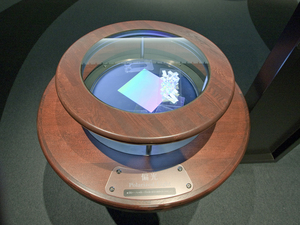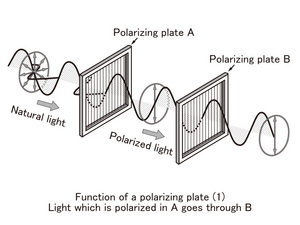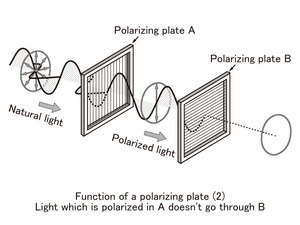Nagoya City Science Museum
TOP > Exhibition Guide > Keyword Search > Starting with "L" > light > Polarized Light
Polarized Light



Purpose of Exhibition
While you enjoy the phenomenon in which transparent plastics can be seen as colored, you can learn about polarized light, light interference, and double-refraction of light.
Additional Knowledge
If a transparent plastic is inserted between two polarizing plates, it can be seen as colored. Some parts of the plastic are not colored and transparent. Why can the transparent plastic be seen as colored?The colored part is where stress is accumulated in the plastic. The stress is produced either when excessive force is applied or when plastic is made. Also, even parts with no color in them can appear colored by applying force and making them stressed. The property by which things appear colored when force is applied, is called "Photoelasticity". By making use of this property, we can find where in a material stress is applied. The area where stress is focused is more breakable. Therefore, by inspecting products under development with photoelasticity, more unbreakable products can be developed. The reason why you can see them colored is related to three phenomena, known as "Polarized Light", "Double-Refraction of Light", and "Light Interference".
[Polarized Light]
Light has the same property as waves. When you look up at the sun, for instance, some sunlight hits the ground, waving horizontally; others wave vertically or diagonally on the ground. They are not polarized only to one particular direction. Such lights are called non- polarized lights. Fluorescent light and light from electric bulbs are also non- polarized lights as well. Polarized lights are the ones waving only toward a particular direction. The unclear disk in the exhibit is called a "Polarizing Plate", which can only allow lights to wave in particular directions. It's said that a polarized plate creates polarized lights. In this exhibit, two polarizing plates are placed face to face with a source of light. Additionally, the polarizing plate above can be turned around. The light emitting from the source of light is not polarized. And the polarized plate below only allows lights through which wave in particular directions. When it does, it only becomes polarized light. By turning the plate above in order to allow the polarized light through you can get a bright light from above. When turning it more to the direction where the polarized light does not penetrate, it becomes dark.
[Double Refraction of Light]
When light enters some kind of material, the light could be divided into two directions. This phenomenon is referred to as double refraction of light. If calcite, a typical mineral which causes double refraction of light, is placed on a book, words can be seen double. The divided waving lights of two are at right angles. But the two waves go at different speeds, when light goes through a material (calcite in this case), and the wave goes up and down at different positions. This is termed as "The phase of waves has changed".
[Interference]
If more than two waves meet one after another, depending on how they meet they become large waves or small waves. This phenomenon is called "Wave Interference". A common example of light interference is the color of soap bubbles. The light reflected on the surface of soap bubbles and the one reflected in the bubble causes interference and a color can be observed by making a particular color intensified. The reasons why transparent plastic can be seen colored are as follows: Waving lights, which only move in one direction, are produced at the polarized plate below, and the lights go into a plastic. In the plastic, the light is split into two and moves at different speeds. When coming out of the plastic, the phases of the two waves differ.
If the light entering into a plastic is white light (containing several colors of lights), the phase difference is different depending on color. There are colors which have different phases. If phases differ, the colors are intensified with interference. At the time when lights come out of the plastic, the two light waves come at right angles. The waves do not interfere. And if you penetrate the two lights in the upper polarizing plate, then interference occurs, the particular colors are intensified, and you can observe them as appearing colored.
Article by Yoshitaka Yamada, curator
